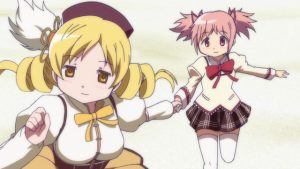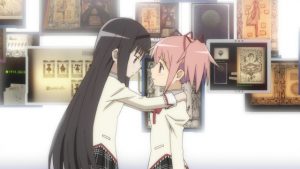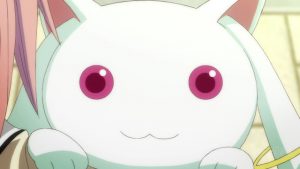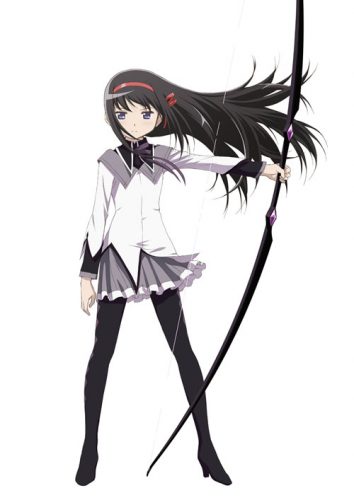
In film, cameras are a window into a character’s thoughts. By moving alongside a character and emulating their actions, a physical closeness develops: a kinesthetic relationship. Through establishing this, a shared space forms, allowing audiences to better understand a character’s psychology.
In the previous article, I mentioned that Homura is the antithesis to the magical girl genre, denying the importance of bonds and emotions. For this article and the next, I’ll go into further detail about how space is distorted for Homura and Madoka Magica’s lack of “movement.”
Sharing Space and Denying It: Context and Cameras
Episode 10 is the first time we inhabit the same “space” as Homura. While she’s been on screen before, she’s kept her distance. To emphasize this, the camera does not follow her when she uses magic. Entering her “space” is purposefully denied--we weren’t meant to understand her yet.
In the previous article, we mentioned that cameras can mimic a character’s movement. By doing so, audiences share a “kinetic empathy.” If you feel what a character is doing, you viscerally relate. However, this isn’t always possible with Homura. Her power makes her movement undetectable. We see her as an outsider; we don’t share her perspective.
With episode 10, we now see through her eyes. When Homura uses her magic, space becomes distorted. The lighting changes, grey becomes prominent--all movement stops. For these few moments, Homura is on her own. When Homura uses her powers she becomes detached from others.
This stands opposed to the genre’s values. If magical girls are given a brighter future, a chance to believe and influence their own world through magic, why does Homura’s world seem so dark? Why does her magic change nothing?
Madoka Magica’s Eye Imagery and “Movement”
To answer the previous questions, we’ll need both perspective and movement. Homura’s character will then be further contextualized in the next section. Now that we share Homura’s perspective, eye imagery is important to understand. Before this, there were two prominent shots where the camera emulated a human eye.
In the show’s opening, when Madoka runs past several buildings, the shot cuts to black. Then the “camera’s eye opens,” revealing Madoka holding a cat. From above, “tears rain down,” as if to say the world cares--the person watching from above cares. The tears trickle past her face, and we share in her relief; all is good with the world.
In the show’s ending, eerie lighting is cast at the center. An eye briefly appears and fades as the ending continues. As Madoka runs into the darkness, the eye opens again, revealing Madoka at its center--the iris. The shot then zooms out, and we see an ominous face. If this cold being has been watching over us, then the world feels frightening and malicious.
If the opening leans towards hope (progresses towards positive), shifting from an opening shot of Madoka crying to her reuniting with friends, then the ending is its opposite with Madoka running towards darkness (progresses towards negative), leaving behind her friends.
However, despite this reading, there is an incongruity. In film theory, lateral movement can influence the perception of a character. Characters moving towards the camera can seem aggressive and characters moving away can seem passive.
Characters who are high above can seem powerful, but characters who are seen very low can seem vulnerable. For further context, this film theory was later tested by Cleveland State University, showing a correlation between the theory and audience interpretation.
This theory also applies with left to right and right to left movement. Traditionally left to right is considered good, a movement towards progress--like reading words on a page. Movement from right to left, however, is the opposite, regression and negative--like going counterclockwise.
Under this assumption, directors across the world have used movement to convey cinematic meaning. Thus, if the opening shifts towards positive, why is Madoka running from right to left? If the ending is mostly negative, why is she running left to right?
These opposing directions create nuance. Madoka runs towards the “past” in the opening, her hopes reaffirmed by a caring world, friendship, and comfort. The opening is a dream, a hope for the future that a simple wish can hold true. Running right to left is then a return to those ideas. For Madoka, her past is a reference point; it allows her to know which direction is “forward.”
The ending with its aimlessness contrasts with how Madoka moves. As she travels, the scenery remains the same: endless and dark. Her running towards the right is progressive, however, she moves towards an unknown future.
Both thematic and physical movements cancel one another. No matter how far Madoka runs in the opening, she will not reach her dream. No matter how far she runs in the ending, she won’t escape her nightmare. This lack of “movement” is more than relevant--it’s the show’s story.
Final Thoughts
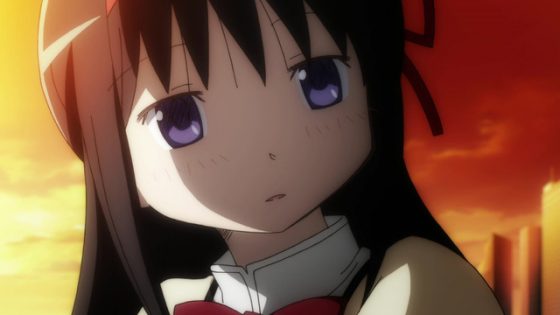
Both thematic and physical movements are important to Madoka Magica. Without both, characters cannot venture inwards or outwards. Without either, there is no meaning to having suffered. In the next article, I will contextualize eye imagery further and how perception reveals Homura’s worldview and the birth of a new “saint.”


